Diseases of Leafy Crucifer Vegetables (collards, kale, mustard, turnips)
Vegetable crops in the crucifer family, grown for their edible leaves include collards, kale, mustard, turnips, and turnip x mustard hybrids. These cool-season crops are well adapted for spring and fall production in Oklahoma. While most of the production is for processing, both processing and fresh markets demand high-quality produce free of blemishes. Diseases are important factors limiting the production of leafy greens. Diseases mainly cause damage by reducing crop quality. Severe disease development can reduce quality to the point where the crop is unmarketable.
Agents (pathogens) that cause the most common diseases of leafy greens are molds (fungi) and bacteria, but diseases caused by viruses and nematodes also can be a problem. This Fact Sheet is intended to aid growers in identifying these diseases and to provide general guidelines for managing them. Accurate identification of a disease is critical to an effective management program. For example, use of a fungicide to control a leaf spot disease will not be effective if the pathogen is a bacteria. Some diseases can routinely be identified in the field with a little experience. For diseases that are difficult to identify in the field, consider submitting samples through local Extension offices to the OSU Plant Disease Diagnostic Laboratory. Consult Fact Sheet
EPP-7612, Plant Disease and Insect Diagnostic Services, for recommended procedures in taking and submitting good samples. Because registrations
of pesticides for disease management change from year to year, consult the latest
edition of the Extension Agent’s Handbook for Insect, Plant Disease, and Weed Control (Extension Circular E-832).
Strategies for Disease Management
Diseases are best managed by minimizing pathogen populations and/or slowing the increase of disease during the growing season. Integrated pest management (IPM) refers to the use of several different management strategies within a crop management system and the judicious use of pesticides where needed. Better, more economical pest control is achieved when IPM is practiced, compared to reliance on a single management strategy such as pesticide application. Disease management strategies that are effective components of IPM programs are listed below. Many of these strategies help prevent diseases from becoming established.
Crop rotation – Fungi, bacteria, and nematodes that cause root and foliar diseases persist in soil or crop debris in the soil. These pathogens build to damaging levels with repeated cropping of crucifer crops. Crop rotation is effective where crops in the crucifer family (also includes cabbage, cauliflower, broccoli, radish, etc.) are avoided for at least two years. Rotations with corn, grain sorghum, or another summer grass crops particularly are beneficial for reducing levels of root-knot nematodes.
Site selection and preparation – Selecting well-drained soils and forming raised beds helps avoid damping-off, root rot, and wilt diseases promoted by water-logged soils. Preparing a good seed bed promotes rapid seedbed germination and seedling growth. Acid soils should be avoided or corrected with lime. Maintaining records on the disease history of fields helps avoid disease problems and the timely use of control measures.
Seed health – Seed contamination, particularly for bacterial diseases such as black rot, is an important means of introducing diseases into non-infested fields. Purchasing high-quality seed from reputable sources helps ensure that seed is pathogen-free. Many seed companies produce seed in dry climates where disease pressure is low and implement quality control programs to minimize the chances for seed contamination. Some seed companies directly test crucifer seed for the presence of the black rot bacterium. Seed lots passing the test are certified black-rot free. Questionable seed lots should soaked in hot water for 20 minutes at exactly 122°F.
Sanitation – Foliar diseases can be spread by equipment and workers moving in and between fields. Soil clinging to equipment and boots is a means of introducing pathogens such as nematodes into clean fields. Equipment and boots should be cleaned when moving from infested fields to clean fields. Clean fields also can be worked before entering infested fields. Fields should not be worked when leaves are wet to limit disease spread.
Irrigation – In sprinkler irrigation, excessive irrigation, or frequent irrigations with small amounts of water favors spread and development of many diseases and should be avoided. Water should be applied during periods when foliage dries rapidly.
Weed control – Weeds in and around fields may harbor viruses and bacteria. For example, common weeds in the crucifer family such as swinecress and Virginia pepperweed are known to harbor black rot bacteria. Practicing good weed control minimizes chances of disease carryover and spread.
Scouting – Crops should regularly be inspected (at least once a week) for symptoms and signs of diseases and other pests. Scouting permits the early detection of pest problems so timely management practices can be implemented.
Chemical control – Fungicide sprays may be needed for effective management of diseases caused by fungi. Copper compounds are used to reduce diseases caused by bacteria as well as fungi. Fungicides and copper sprays help prevent healthy plants from becoming infected, but cannot cure plants already diseased. Therefore,
applications should be made before symptoms appear where disease is anticipated or shortly after the disease is first detected. Because fungicides degrade over time, repeated applications on a seven to 14-day schedule typically are required to maintain protection. Sprays should be applied before anticipated rains rather than after, since protection is afforded during wet periods that favor infection. Sprays should be applied in a sufficient volume to achieve thorough plant coverage. The number of fungicides registered for use on leafy greens is limited; therefore it is critical to use IPM strategies along with chemical control.
Seed and soil-applied fungicides also are used to manage soilborne diseases. Seed treatments are recommended to help prevent damping-off of seedlings. Soil-applied fungicide is pre-plant incorporated, applied to the seed furrow, or banded over the row and watered in. Soil-applied fungicide provides additional damping-off control, and may help reduce root-rot diseases.
Diseases are best managed by minimizing pathogen populations and/or slowing the increase of disease during the growing season. Integrated pest management (IPM) refers to the use of several different management strategies within a crop management system and the judicious use of pesticides where needed. Better, more economical pest control is achieved when IPM is practiced, compared to reliance on a single management strategy such as pesticide application. Disease management strategies that are effective components of IPM programs are listed below. Many of these strategies help prevent diseases from becoming established.
Crop rotation – Fungi, bacteria, and nematodes that cause root and foliar diseases persist in soil or crop debris in the soil. These pathogens build to damaging levels with repeated cropping of crucifer crops. Crop rotation is effective where crops in the crucifer family (also includes cabbage, cauliflower, broccoli, radish, etc.) are avoided for at least two years. Rotations with corn, grain sorghum, or another summer grass crops particularly are beneficial for reducing levels of root-knot nematodes.
Site selection and preparation – Selecting well-drained soils and forming raised beds helps avoid damping-off, root rot, and wilt diseases promoted by water-logged soils. Preparing a good seed bed promotes rapid seedbed germination and seedling growth. Acid soils should be avoided or corrected with lime. Maintaining records on the disease history of fields helps avoid disease problems and the timely use of control measures.
Seed health – Seed contamination, particularly for bacterial diseases such as black rot, is an important means of introducing diseases into non-infested fields. Purchasing high-quality seed from reputable sources helps ensure that seed is pathogen-free. Many seed companies produce seed in dry climates where disease pressure is low and implement quality control programs to minimize the chances for seed contamination. Some seed companies directly test crucifer seed for the presence of the black rot bacterium. Seed lots passing the test are certified black-rot free. Questionable seed lots should soaked in hot water for 20 minutes at exactly 122°F.
Sanitation – Foliar diseases can be spread by equipment and workers moving in and between fields. Soil clinging to equipment and boots is a means of introducing pathogens such as nematodes into clean fields. Equipment and boots should be cleaned when moving from infested fields to clean fields. Clean fields also can be worked before entering infested fields. Fields should not be worked when leaves are wet to limit disease spread.
Irrigation – In sprinkler irrigation, excessive irrigation, or frequent irrigations with small amounts of water favors spread and development of many diseases and should be avoided. Water should be applied during periods when foliage dries rapidly.
Weed control – Weeds in and around fields may harbor viruses and bacteria. For example, common weeds in the crucifer family such as swinecress and Virginia pepperweed are known to harbor black rot bacteria. Practicing good weed control minimizes chances of disease carryover and spread.
Scouting – Crops should regularly be inspected (at least once a week) for symptoms and signs of diseases and other pests. Scouting permits the early detection of pest problems so timely management practices can be implemented.
Chemical control – Fungicide sprays may be needed for effective management of diseases caused by fungi. Copper compounds are used to reduce diseases caused by bacteria as well as fungi. Fungicides and copper sprays help prevent healthy plants from becoming infected, but cannot cure plants already diseased. Therefore, applications should be made before symptoms appear where disease is anticipated or shortly after the disease is first detected. Because fungicides degrade over time, repeated applications on a seven to 14-day schedule typically are required to maintain protection. Sprays should be applied before anticipated rains rather than after, since protection is afforded during wet periods that favor infection. Sprays should be applied in a sufficient volume to achieve thorough plant coverage. The number of fungicides registered for use on leafy greens is limited; therefore it is critical to use IPM strategies along with chemical control.
Seed and soil-applied fungicides also are used to manage soilborne diseases. Seed treatments are recommended to help prevent damping-off of seedlings. Soil-applied fungicide is pre-plant incorporated, applied to the seed furrow, or banded over the row and watered in. Soil-applied fungicide provides additional damping-off control, and may help reduce root-rot diseases.
Residue management – Since many pathogens survive in and on crop debris, crop residue should be incorporated by disking or plowing soon after harvest to promote rapid decomposition.
Soilborne Diseases
Damping-off (Fusarium, Rhizoctonia,
and Pythium spp.)
Damping-off is a term used to describe the different phases of seed and seedling disease. Several fungi that commonly inhabit agricultural soils may contribute to damping-off problems within a single field. Damage results from reduced plant stand, which in severe cases results in reduced yield or the added expense of replanting. Damping-off is favored by poor drainage, compacted soil, and soil crusting. Most species of Pythium are active when soil is cold while Rhizoctonia prefers warm soil temperatures. Plants beyond the third or fourth leaf stage are no longer susceptible.
Symptoms – Failure of seedlings to emerge from the soil, as a result of seed or seedling decay, is called pre-emergence damping-off. The collapse and sudden death of emerged seedlings is called seedling blight or post-emergence damping-off. Roots and lower stems of emerged seedlings become soft and watery, and may be reddish-brown in color. Seedlings die when roots are completely decayed or stems are girdled.
Control – A good seedbed, free of crop debris, should be prepared in a well-drained site. A registered, fungicide seed treatment should be applied or pre-treated seed should be purchased. If possible, avoid planting in cold soils (below 55°F).
Root-knot (Meloidogyne spp.)
Root-knot is caused by several species of nematodes, which are microscopic roundworms that live in soil and feed on plant roots. Crucifers are susceptible to all root-knot species. In Oklahoma, both northern and southern root-knot nematodes are present and both cause damage to vegetable crops in isolated fields. Where nematode populations are high, yield loss results from poor plant growth. Nematodes are most severe on sandy, well-drained soils. Fortunately, nematodes are most active during the summer when these crops are not grown.
Symptoms – Affected plants are pale green to yellow, stunted, and may occur in patches along rows or in circular areas. Roots of affected plants show the characteristic galls or swellings caused by nematode feeding. The southern root-knot nematode causes large galls that may be up to a half-inch thick, while galls caused by the northern root-knot nematode are finer in appearance.
Control – Crop rotation with grass crops for at least two years effectively reduces nematode populations below damaging levels. Rotations with other broadleaf vegetable crops should be avoided, since most are susceptible to root-knot. Soil should be tested for nematodes prior to planting in fields with a history of nematode problems to ensure that the populations are below damaging levels. See OSU Extension Fact Sheet EPP-7610 for more information on sampling procedures for nematodes.
Bacterial Leaf Diseases
Bacterial diseases have been important foliar diseases of leafy greens in Oklahoma. Bacterial diseases are serious, since they spread rapidly and cause direct damage to the marketed portion of the crop. In addition, chemical controls are not very effective. While the causes and symptoms of each disease are different, management programs are similar.
Black rot (Xanthomonas campestris pv. campestris)
Black rot is a widespread and destructive disease of crucifer crops in Oklahoma. Entire fields can be destroyed when conditions are favorable for disease development. The disease is caused by a bacterium that survives on seed, weedy crucifers, and crop debris in infested fields. Extended periods of warm and wet weather favor rapid spread and infection. Therefore, black rot is most severe in the spring production season as temperatures warm. The disease is spread rapidly by splashing and running water, insects, and workers or equipment moving through fields. Infection primarily occurs through the hydathodes, which are natural openings at the leaf margins, during periods of prolonged dew or rainy weather. If infected plants survive to harvest, leaves with symptoms are not marketable.
Symptoms – Plants at any stage of development are susceptible. Seedlings from infected seed die quickly and serve as sources of the bacteria that infect other plants. On true leaves, the disease is easily recognized by the presence of yellow V-shaped lesions extending inward from the leaf margins (Figure 1). The center of the lesion dries out and turns brown, and veins within the lesion appear blackened. The lesions extend into the leaf, killing large areas of affected leaves. Older leaves with lesions may develop numerous black, oval spots on the petioles and soon drop from the plant. Cutting into stems and petioles of severely affected plants reveals a black discoloration of the vascular system.
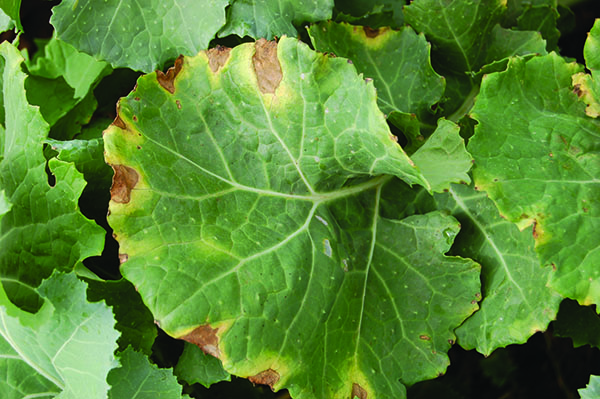
Figure 1. Kale with V-shaped lesions at the leaf margin caused by black rot.
Xanthomonas leaf spot (Xanthomonas campestris pv. armoraciae)
Xanthomonas leaf spot is caused by a bacterium nearly identical to the one causing black rot, except that it causes leaf spot and does not invade the vascular system. Xanthomonas leaf spot, along with bacterial leaf spot, have been important causes of poor quality of leafy greens in recent years. When leaf spotting is widespread and severe, greens may not be suitable for harvest. Turnips, kale, and collards are very susceptible while mustard and turnip x mustard hybrids are less severely affected. Sources of bacteria and conditions favoring infection and disease development are the same as those for black rot.
Symptoms – Numerous small, circular, leaf spots (lesions) appear scattered over leaves. Lesions are about 1/8-inch in diameter, tan to dark brown in color and are often surrounded by a yellow border (Figure 2). Spots often appear oily or water-soaked on the undersides of leaves. Where numerous, spots coalesce and turn large areas of leaves yellow. (Figure 3) Spots later dry and turn papery brown. Severely diseased leaves may develop numerous black, oval spots on the petioles.
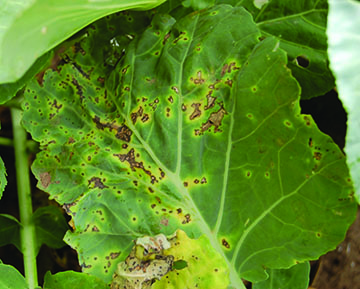
Figure 2. Kale leaf with Xanthomonas leaf spot.
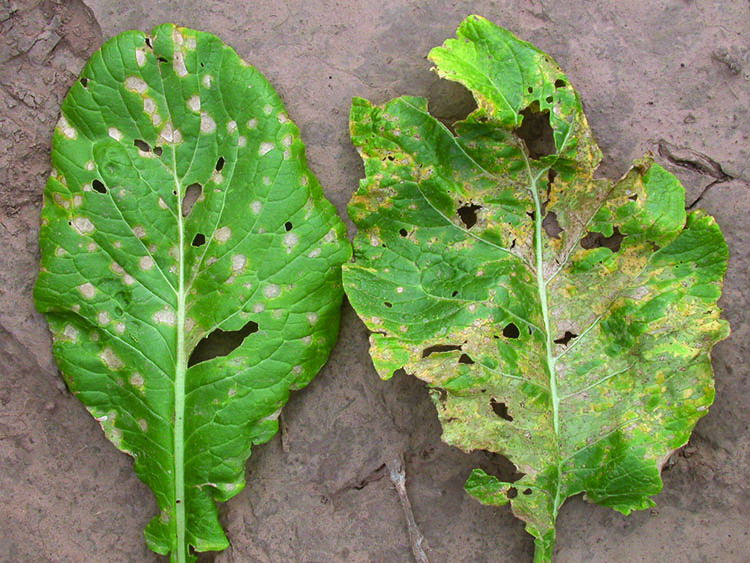
Figure 3. Turnip leaves with white spot caused by the fungus Cercospora (left) and Xanthomonas leaf spot caused by bacteria (right).
Bacterial leaf spot (Pseudomonas syringae pv. maculicola)
This leaf spot disease resembles Xanthomonas leaf spot caused, and has commonly been found in fields severely infested with bacterial diseases. Bacterial leaf spot is favored by cooler temperatures than black rot and Xanthomonas leaf spot, and is likely to be a problem in the fall and early spring.
Symptoms – Leaf spots are at first small, circular to angular in shape, grey to light brown in color, and appear oily or water-soaked on the lower leaf surface (Figure 4). Bacterial leaf spots typically lacks the pronounced yellow border that surrounds spots caused by Xanthomonas leaf spot. Spots expand, coalesce into irregular shapes, turn light brown in color, and may advance along leaf veins (Figure 5). Severely infected leaves dry and become brittle as they are killed.
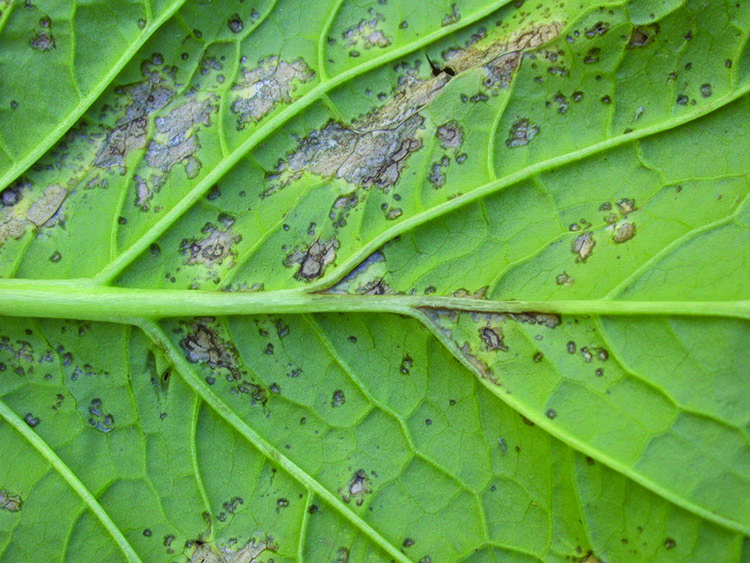
Figure 4. Underside of turnip leaf with bacterial leaf spot.
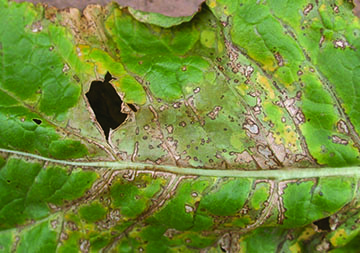
Figure 5. Upper side of turnip leaf with bacterial leaf spot.
Control – Control of bacterial diseases is effective only when the pathogen(s) are excluded from fields. Once bacterial pathogens are present in a field, control will be impossible under conditions favorable for infection. Purchase seed that has been tested and certified to be free of black-rot bacteria or hot-water treat seed as previously described. Because the bacterium that causes Xanthomonas leaf spot is closely related to the one that causes black rot, seed testing procedures for black rot also will detect this bacterium. However, seed testing procedures for bacterial leaf spot have not been developed. Plant seed in fields that have not been planted to crucifer crops for at least two years so that residue from previous crops is completely decomposed. Manage old crop residue to hasten its decomposition because the bacteria survive best on the soil surface and are poor soil competitors. Control of wild crucifers that may harbor bacteria in and around fields may reduce disease. Fields should not be worked while plants are wet because the bacteria are efficiently spread by mechanical means. While crucifers grown for production of leafy greens are usually direct seeded; nearby gardens, transplanted fields, and diseased fields also can serve as sources of the bacterium.
Foliar Diseases Caused by Fungi
Leaf spotting diseases are caused by several different fungi that attack one or more of the leafy greens crops grown in Oklahoma. These diseases are important because they have a direct effect on the quality of the harvested leaves. Even slight damage reduces marketability. The relative importance of each disease and their symptoms is described separately for each disease. However, management practices for disease control are similar.
White leaf spot (Cercospora or Cercosporella spp.)
Leaf spot diseases caused by these two fungi are similar in their symptoms, biology, and damage. Cercospora has been more frequent in recent years, but both are probably present. White spot is most severe on turnip, mustard, and turnip x mustard hybrids. The disease is less important on collards and kale. The fungi persist on infested crop residue and possibly wild crucifer weeds. Spores from debris, weeds, or neighboring fields become airborne and are blown to new fields. The disease has been most severe in the fall production season, but can occur whenever prolonged leaf wetness occurs at temperatures of 55 to 65°F.
Symptoms – Circular white spots ranging in size from 1/4 to 1/2-inch in diameter are scattered over leaves (Figure 4). As the spots age, they may develop darkened borders (Figure 6). Severely affected leaves turn yellow, become dry, and wither, while remaining attached to the plant.
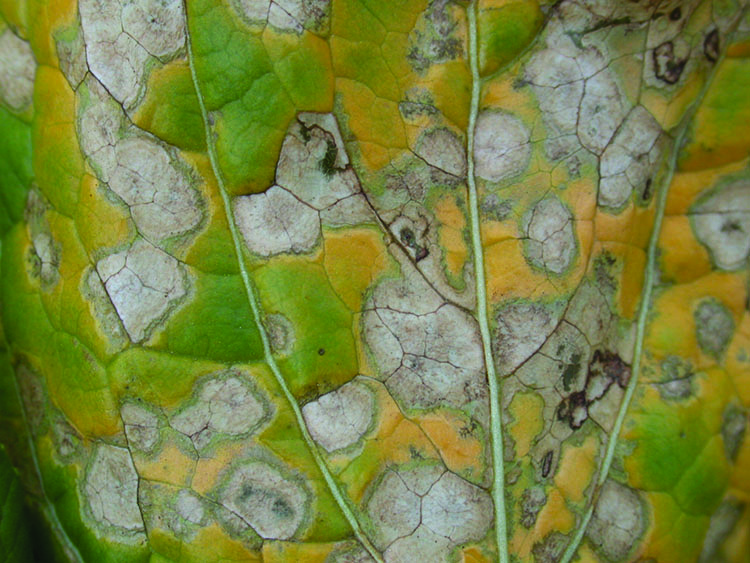
Figure 6. White spot on turnip leaf producing circular spots with dark borders and leaf yellowing.
Black leaf spot (Alternaria brassicae)
Black leaf spot is less common than white leaf spot in Oklahoma, but it can be a problem on turnips and collards. The fungus can be carried on seed, but also persists in infested crop debris and alternate weed hosts. Spores of the fungus are spread mainly by wind and splashing rain. At least nine continuous hours of dew or rain are required for infection. Optimum temperatures for infection range from 75 to 82°F.
Symptoms – Leaf spots are circular, brown, and may develop a target-like appearance with dark brown to black circles within the circles (Figure 7). Spots, which may expand up to one inch in diameter, are more frequent on older leaves.
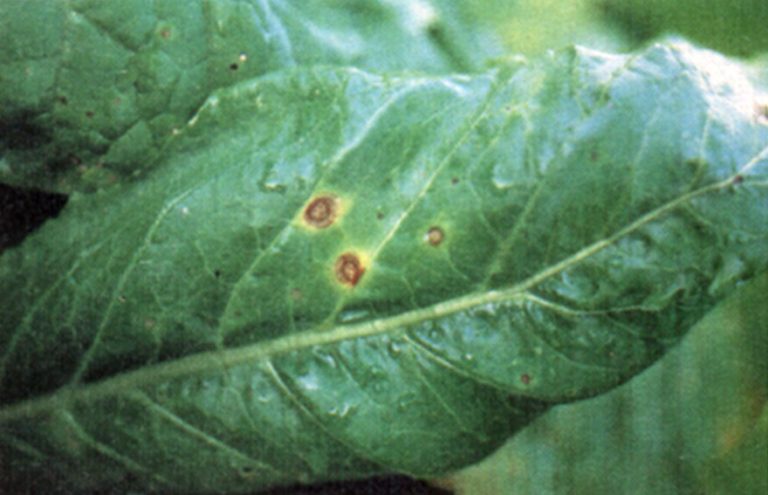
Figure 7. Black spot on turnip leaf.
Anthracnose (Colletotrichum higginsianum)
Anthracnose occurs in Oklahoma, but is less common than white spot. The disease is most severe on turnip, but can also attack kale, collard, mustard, and turnip x mustard. The fungus persists in infested crop residue and crucifer weeds but also may be carried on seed. Warm (79 to 86°F), wet weather favors infection and disease development.
Symptoms – Leaf spots are small, dry, circular, and pale gray to straw colored (Figure 8). Darker colored areas within the older spots are reproductive structures of the fungus. Severely infected leaves are killed. Spots on petioles are elongated, sunken, grey to brown, and have a dark black border.
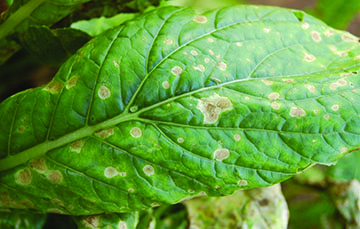
Figure 8. Anthacnose on turnip x mustard leaf.
Downy mildew (Peronospora parasitica)
Downy mildew is caused by a fungus closely related to the one that causes white rust. The disease occurs sporadically in Oklahoma, but is potentially destructive. The fungus persists in fields as resistant spores embedded in old crucifer roots and tops. The fungus grows to seedlings where it produces wind-blown spores that infect other plants or new fields during prolonged periods of wet weather when temperatures are cool (below 75°F).
Symptoms – The disease can attack plants at any stage of development. Downy mildew first appears as a white to grey mildew mostly found on the undersides of leaves (Figure 9). Yellow areas later develop on the corresponding upper sides (Figure 10). Infected areas enlarge and their centers turn tan to light brown in color and papery in texture. When the disease is severe, entire leaves turn yellow and die.
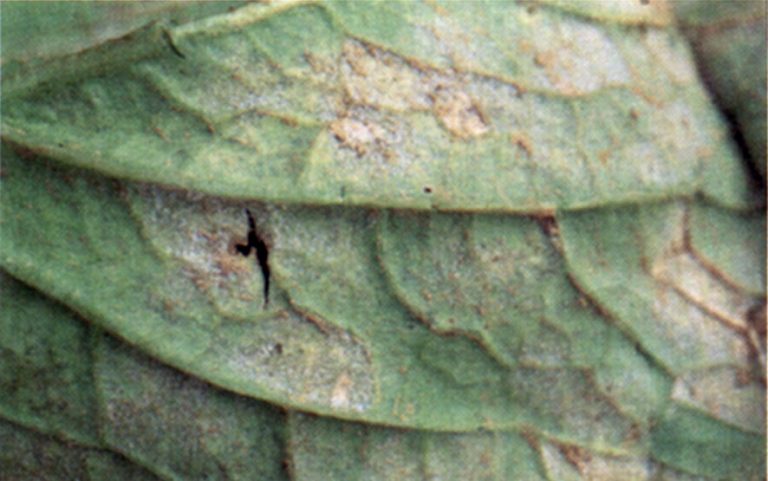
Figure 9. White mildew on lower side of turnip leaf caused by downy mildew. (Photo courtesy S.C. Bost, University of Tennessee).
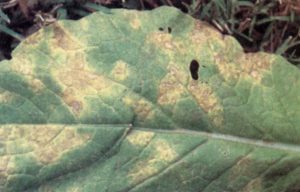
Figure 10. Yellow leaf spots on upper side of turnip leaf caused by downy mildew. (Photo courtesy S.C. Bost, University of Tennessee)
White rust (Albugo candida)
White rust is a chronic disease problem for spinach production in Oklahoma. White rust of crucifers, which is caused by a different species of the white rust fungus, has not been severe in Oklahoma, but has been reported. The fungus persists in soil as resistant spores that can survive for many years and initiate disease cycles. Thereafter, disease increases from airborne spores that spread within and between fields. Cool (60 to 77°F) and wet weather is favors infection.
Symptoms – Yellow spots occur on the upper surface of infected leaves. Numerous small, white, blister-like pustules are scattered on the undersides of leaves (Figure 11). The pustules, which contain spores of the fungus, appear as a white chalky dust. Severely affected leaves may become distorted.
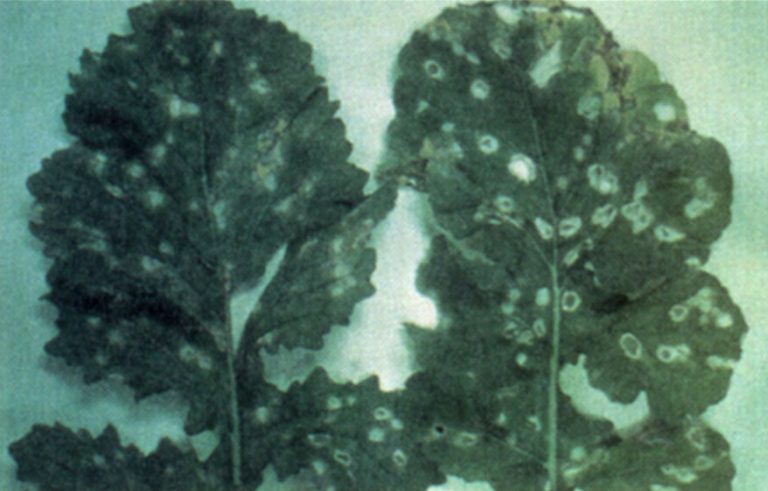
Figure 11. Figure 11. White rust on mustard leaves. (Photo courtesy J.D. Gay, University of Georgia)
Control – Cultural practices help prevent foliar diseases from becoming established in a crop. Incorporate crop residue soon after harvest to hasten its decomposition and reduce pathogen survival. Practice crop rotation with non-crucifer crops for at least two years. These cultural practices reduce pathogen populations and delay initial infections. Prepare a well-drained seed bed that is free of plant residues. Plant high-quality seed produced in dry climates and treated with a fungicide to reduce the likelihood of introducing disease on seed. Seed testing procedures are not available for fungal diseases. Therefore, seed treatment with a fungicide is recommended. Control weeds in and around fields, particularly wild crucifers, which may harbor fungal diseases. Leaf spot diseases may develop during periods favorable for infection in spite of these preventive practices. A fungicide spray program is the only effective method of control. Fungicides should be applied according to label directions and repeated if conditions favorable for infection persist. If possible, anticipate disease problems and begin a spray schedule before economic damage occurs. Consult the Extension Agents Handbook of Insect, Disease and Weed Control (Extension Circular E-832) for more information on fungicides currently registered for disease control on leafy greens.
John Damicone
Extension Plant Pathologist
